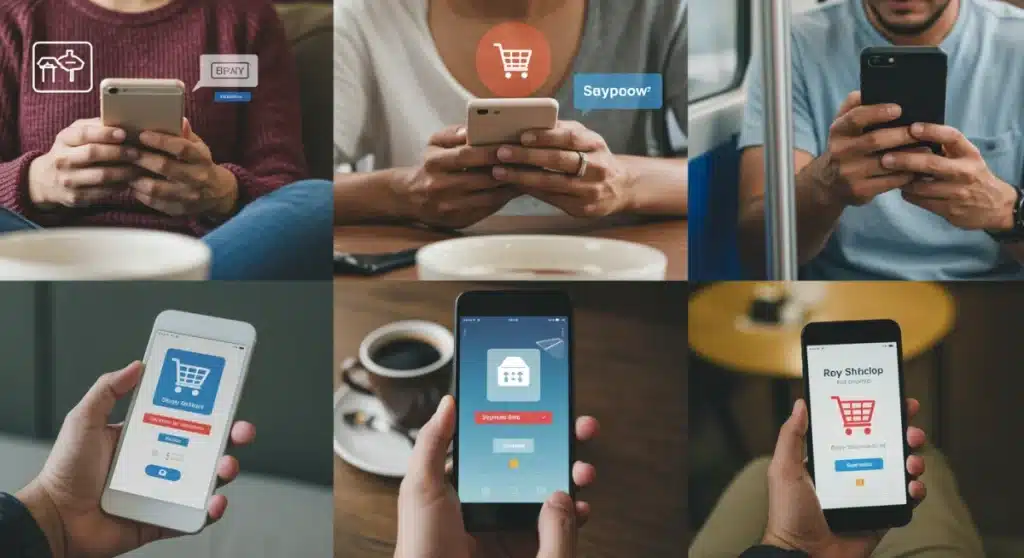Mobile Dominates US Online Shopping: Over 50% Purchases Now Made on Devices

Over 50% of U.S. online purchases are now made via mobile devices, signaling a definitive shift in e-commerce and consumer preferences towards smartphone and tablet-based shopping.
Did You Know that over 50% of U.S. online purchases are now made via mobile devices? This significant milestone, recently confirmed by industry reports, reshapes our understanding of consumer behavior and the future of e-commerce. It’s a clear indication that mobile is not just a browsing tool but the primary platform for transactions.
The Pivotal Shift to Mobile Commerce
The landscape of online shopping in the United States has undergone a dramatic transformation. For the first time, more than half of all digital retail transactions are now completed on mobile devices, including smartphones and tablets. This isn’t just a trend; it’s a fundamental change in how consumers interact with brands and make purchasing decisions.
This critical development underscores the importance of mobile-first strategies for businesses of all sizes. Companies that fail to adapt to this mobile-centric reality risk falling behind in an increasingly competitive digital marketplace. The convenience and accessibility offered by mobile devices have become paramount for today’s shopper.
Understanding Mobile-First Consumer Behavior
Consumers are increasingly relying on their mobile devices for every stage of the shopping journey, from product discovery to final purchase. This behavior is driven by several factors, including the ubiquity of smartphones and improved mobile shopping experiences.
- Instant Gratification: Mobile devices enable immediate purchases anytime, anywhere.
- Seamless Experience: Improved app design and responsive websites enhance user satisfaction.
- Personalized Offers: Mobile platforms allow for highly targeted marketing and deals.
- Convenient Payments: Integrated mobile payment options streamline the checkout process.
Driving Forces Behind Mobile Dominance
Several key factors are propelling the surge in mobile online purchases. Technological advancements, coupled with evolving consumer expectations, have created a perfect storm for mobile commerce to flourish.
Faster internet speeds, particularly 5G, have made mobile browsing and shopping smoother than ever before. Additionally, the continuous improvement of e-commerce platforms and retail apps has significantly enhanced the user experience, making mobile transactions not only possible but preferable for many.
Technological Advancements and User Experience
Modern smartphones boast powerful processors and high-resolution screens, making product viewing and interaction more engaging. Retailers have also invested heavily in optimizing their websites and developing intuitive mobile applications.
- Responsive Design: Websites automatically adjust to any screen size for optimal viewing.
- Dedicated Apps: Retailer-specific apps offer exclusive features and a streamlined interface.
- Augmented Reality (AR): AR features allow customers to visualize products in their own environment before buying.
- Voice Commerce: The rise of voice assistants is making hands-free shopping a growing segment.
Implications for E-commerce Businesses
The shift to mobile dominance carries profound implications for businesses operating in the e-commerce space. Adapting to this new reality is no longer optional; it is essential for survival and growth. Companies must re-evaluate their digital strategies to prioritize mobile users.
This involves more than just having a mobile-friendly website. It requires a holistic approach that considers every touchpoint a customer might have with a brand on their mobile device, from social media engagement to post-purchase support.
Adapting Strategies for Mobile Success
To thrive in this mobile-first environment, businesses need to implement specific strategies designed to cater to mobile shoppers. This includes optimizing performance, simplifying navigation, and ensuring secure payment options.
Mobile page load speed is critical; even a slight delay can lead to significant cart abandonment rates. Furthermore, one-click purchasing and guest checkout options can greatly reduce friction, making the buying process quicker and more enjoyable for mobile users.

Security and Trust in Mobile Transactions
As mobile online purchases surge, so does the importance of robust security measures and fostering consumer trust. Shoppers need to feel confident that their personal and financial information is protected when transacting on their devices.
Retailers are implementing advanced encryption technologies, multi-factor authentication, and secure payment gateways to safeguard mobile transactions. Building and maintaining this trust is paramount for sustained growth in the mobile commerce sector.
Consumer education also plays a role, with users becoming more aware of how to identify secure websites and apps. Brands that transparently communicate their security protocols often gain a competitive edge by reassuring their customer base.
Key Security Measures for Mobile Shoppers
Ensuring a secure mobile shopping environment involves a combination of technological safeguards and best practices. Both retailers and consumers share responsibility in protecting against cyber threats.
- SSL Certificates: Encrypt data transmitted between the user’s device and the website.
- Payment Tokenization: Replaces sensitive card data with a unique identifier.
- Biometric Authentication: Fingerprint or facial recognition for secure app access and payments.
- Fraud Detection Systems: AI-powered tools monitor transactions for suspicious activity.
The Future of Mobile Online Purchases
The trajectory of mobile online purchases indicates continued growth and innovation. Experts predict that mobile’s share of e-commerce will only expand, driven by emerging technologies and evolving consumer demands. This ongoing evolution will introduce new ways to shop and interact with brands.
Expect to see further integration of artificial intelligence in personalized shopping experiences, more sophisticated augmented reality applications, and the mainstream adoption of seamless, frictionless payment methods. The lines between physical and digital shopping will continue to blur, with mobile devices acting as the central hub for this convergence.
The focus will remain on creating highly intuitive, efficient, and enjoyable mobile shopping journeys. Retailers who anticipate these changes and invest in cutting-edge mobile solutions will be best positioned to capture market share and foster customer loyalty in the years to come.
Challenges and Opportunities in Mobile Commerce
While the dominance of mobile online purchases presents immense opportunities, it also comes with its own set of challenges. Businesses must navigate these complexities to fully capitalize on the mobile wave. Addressing these challenges effectively can unlock significant growth potential.
One primary challenge is optimizing for a vast array of devices and operating systems, ensuring a consistent and high-quality experience across all platforms. Another is managing the increasing expectations of consumers for instant gratification and personalized service, which mobile platforms often amplify.
Overcoming Obstacles and Maximizing Potential
Retailers are employing various strategies to tackle the hurdles in mobile commerce, transforming them into opportunities for innovation and competitive advantage.
- Progressive Web Apps (PWAs): Offer app-like experiences directly through web browsers, reducing download friction.
- Omnichannel Integration: Blending online and offline experiences seamlessly through mobile devices.
- Data Analytics: Utilizing mobile usage data to understand customer behavior and personalize offerings.
- Customer Support: Implementing chatbots and in-app support for immediate assistance on mobile.
| Key Point | Brief Description |
|---|---|
| Mobile Dominance | Over 50% of U.S. online purchases now occur on mobile devices, a significant shift. |
| Consumer Behavior | Driven by convenience, instant gratification, and seamless user experiences. |
| Business Adaptation | Retailers must prioritize mobile-first strategies, optimized interfaces, and secure transactions. |
| Future Trends | Continued growth, AI integration, AR applications, and frictionless payment methods. |
Frequently Asked Questions About Mobile Commerce
Mobile purchases are exceeding desktop due to increased smartphone penetration, improved mobile website and app experiences, and the convenience of shopping anytime, anywhere. Consumers value the ease of completing transactions on their devices without needing a computer.
This shift mandates that e-commerce businesses adopt mobile-first design principles, optimize website loading speeds for mobile, and ensure seamless, secure mobile payment options. Failing to prioritize mobile can lead to lost sales and decreased customer satisfaction in the competitive digital landscape.
Yes, mobile payment options are generally secure. Reputable retailers and payment processors use advanced encryption, tokenization, and multi-factor authentication to protect sensitive data. Consumers should always ensure they are using trusted apps and secure networks for transactions.
Upcoming trends include greater integration of artificial intelligence for personalized recommendations, widespread adoption of augmented reality (AR) for product visualization, further development of voice commerce, and even more frictionless one-click purchasing experiences to enhance user convenience.
Consumers can ensure a good experience by using fast and reliable internet, keeping apps updated, looking for responsive and easy-to-navigate websites, and utilizing secure payment methods. Checking reviews and retailer reputations also contributes to a positive and safe mobile shopping journey.
Looking Ahead
The fact that over 50% of U.S. online purchases are now mobile is not merely a statistic; it’s a profound indicator of a new era in retail. This trend is set to accelerate, driven by continuous technological innovation and evolving consumer expectations. Businesses must remain agile, investing in mobile optimization, secure payment solutions, and personalized experiences to stay relevant. The mobile device is no longer just a communication tool; it is the primary gateway to the global marketplace, shaping how we buy, sell, and interact with brands on an unprecedented scale.